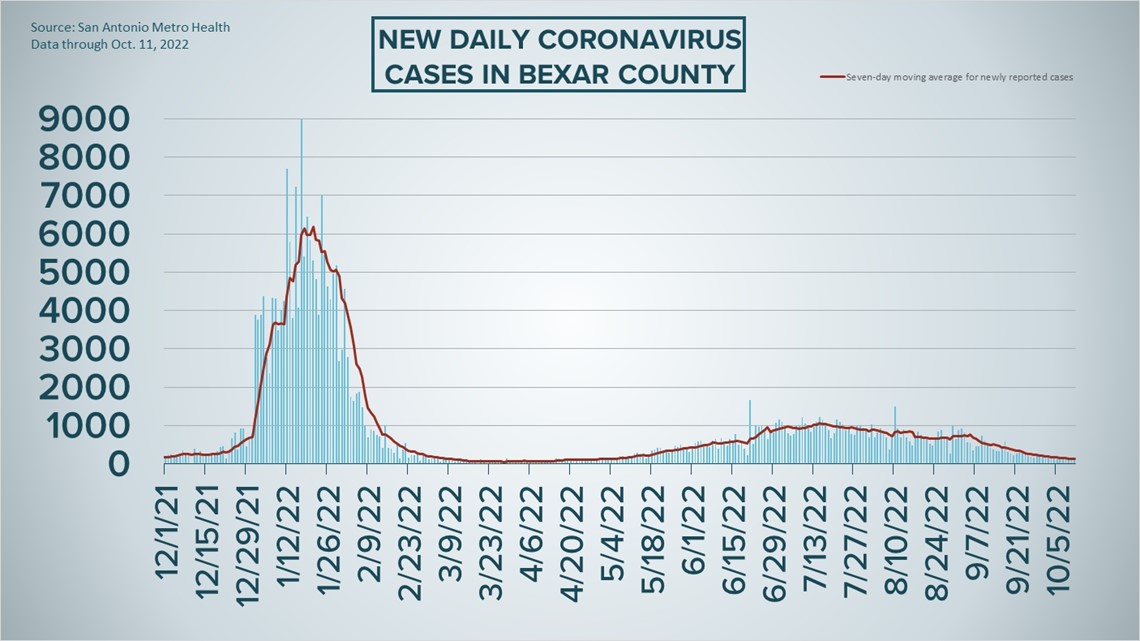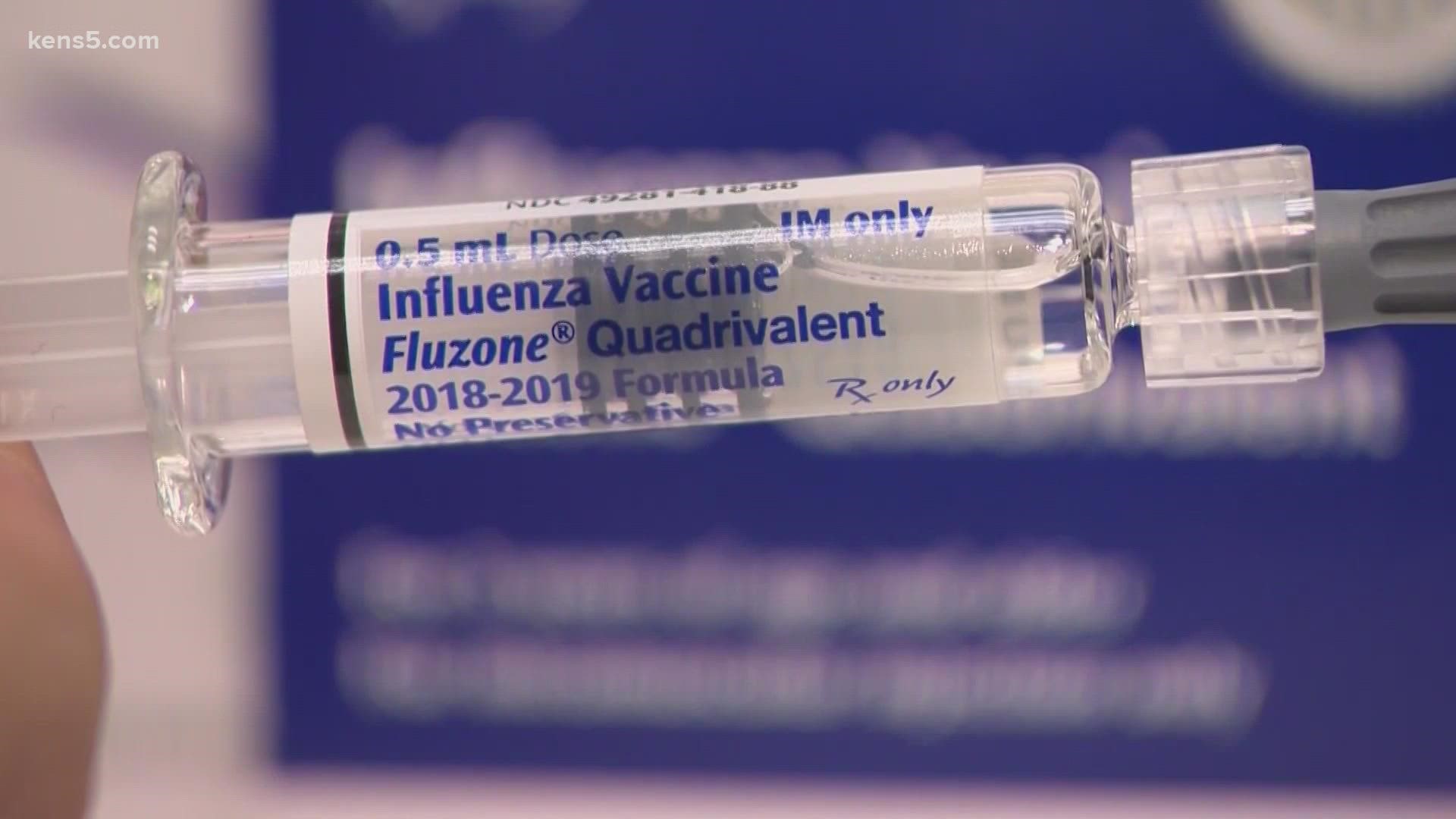SAN ANTONIO — Single-day COVID-19 case counts dropped to double-digits over the weekend for the first time in months as San Antonio's risk level for virus spread remained at "low" and "improving" this week.
Before Sunday, May 3 was the last time Bexar County tallied fewer than 100 new infections, ahead of a summer wave that saw numbers jump in July. Tuesday's count was close, as health authorities recorded just 102 new COVID-19 cases, bringing the seven-day case average down – again – to its lowest levels since early May.
October has seen an average of just 136 new cases a day so far, down from 414 in September and 735 the month before.
The trends also continue at local hospitals, where 130 COVID-19 patients were receiving treatment for their symptoms on Tuesday. That number constitutes a small uptick from the weekend figures, but the long-term outlook remains positive; hospitalizations are down by 38% since Sept. 1.
The next no-cost COVID-19 vaccine pop-up clinics organized by Metro Health are set for Wednesday and Thursday mornings.
More than 645,000 COVID-19 infections have been reported in San Antonio (though that figure likely doesn't include most at-home tests, which could number in the thousands), while 5,418 residents have died from virus complications.
How Bexar County is trending




Vaccine progress in Bexar County
The following numbers are provided by San Antonio Metro Health. A full breakdown can be found here.
- 1,478,351 eligible Bexar County residents are fully vaccinated as of Sept. 26, which is about 77.8% of the total population over the age of 4.
- 585,581 eligible Bexar County residents have received a COVID-19 booster shot as of Sept. 26, which is 40.8% percent of the population.
The CDC states that "when a high percentage of the community is immune to a disease (through vaccination and/or prior illness)," that community will have reached herd immunity, "making the spread of this disease from person to person unlikely."
The City of San Antonio breaks down the vaccination rates by zip code on Metro Health's Vaccination Statistics page.
Coronavirus in Texas
The total number of coronavirus cases in the state grew by 1,416 on Monday, according to the Texas Department of State Health Services. That total includes 962 new confirmed cases and 454 new probable cases. More details can be found on this page.
Monday's figures bring the total number of Texans diagnosed with COVID-19 to more than 7.89 million.
Meanwhile, one more Texan has died from virus complications, the state reported Monday, raising the statewide death toll to 89,344. The latest daily figures, for Tuesday, weren't yet released by state officials.
Coronavirus symptoms
The symptoms of coronavirus can be similar to the flu or a bad cold. Symptoms include fever or chills, cough, shortness of breath or difficulty breathing, fatigue, muscle or body aches, headache, new loss of taste or smell sore throat, congestion or runny nose, nausea or vomiting, and diarrhea, according to the Centers for Disease Control.
Most healthy people will have mild symptoms. A study of more than 72,000 patients by the Centers for Disease Control in China showed 80 percent of the cases there were mild.
But infections can cause pneumonia, severe acute respiratory syndrome, kidney failure, and even death, according to the World Health Organization. Older people with underlying health conditions are most at risk.
Experts determined there was consistent evidence these conditions increase a person's risk, regardless of age:
- Chronic kidney disease
- COPD (chronic obstructive pulmonary disease)
- Obesity (BMI of 30 or higher)
- Immunocompromised state (weakened immune system) from solid organ transplant
- Serious heart conditions, such as heart failure, coronary artery disease, or cardiomyopathies
- Sickle cell disease
- Type 2 diabetes
- The CDC believes symptoms may appear anywhere from two to 14 days after being exposed.
Human coronaviruses are usually spread...
- Between people who are in close contact with one another (within about 6 feet).
- Through respiratory droplets produced when an infected person coughs, sneezes or talks. These droplets can land in the mouths or noses of people who are nearby or possibly be inhaled into the lungs.
- Some recent studies have suggested that COVID-19 may be spread by people who are not showing symptoms.
Help stop the spread of coronavirus
- Stay home when you are sick.
- Eat and sleep separately from your family members
- Use different utensils and dishes
- Cover your cough or sneeze with your arm, not your hand.
- If you use a tissue, throw it in the trash.
Find a testing location
City officials recommend getting a COVID-19 test if you experience fever or chills, cough, shortness of breath or difficulty breathing, fatigue, muscle or body aches, headache, new loss of taste or smell, sore throat, congestion or runny nose, nausea or vomiting, or diarrhea.
Here's a Testing Sites Locator to help you find the testing location closest to you in San Antonio.
Latest Coronavirus Headlines
- COVID Tracker: Start of October continues positive trends for San Antonio, Bexar County
- Getting this year's flu shot is a must | Wear the Gown
- Homelessness surging in many cities as COVID relief programs end
- Why do scientists think the COVID pandemic may have changed our personalities?
- The flu is back, and could be worse than usual this year
- Pfizer seeks to expand omicron booster to 5- to 11-year-olds
- Health experts urge people of color to get COVID-19 boosters
- 4.4M Americans roll up sleeves for omicron-targeted boosters

